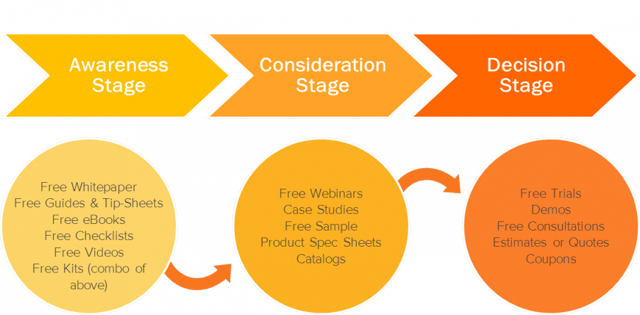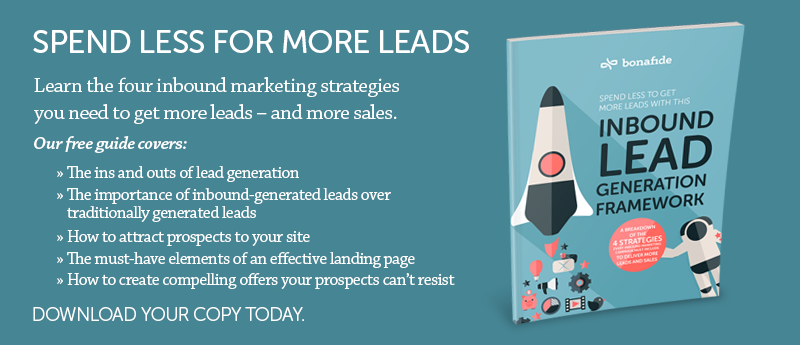
Marketing and sales teams don’t always agree.
Does this sound familiar? Your marketing team feels like they send lots of great leads to the sales team, but sales doesn’t seem to convert many of them into customers. Your sales team feels like marketing is sending them mere contacts rather than leads and that their time could be better spent elsewhere.
The issue here centers around what a qualified lead actually looks like. Each team has their own definition of them, but in order to make a sale, both teams need to agree on what a sales qualified lead looks like for the business.
What Is A Sales Qualified Lead?
A sales qualified lead (SQL) is simply a prospective customer that is likely to make a purchase. You know they are likely to do so because your team has already gathered the research that says so.
This is a customer that isn’t just curious, or even engaged. They are ready to bite. Knowing whether or not a customer is an SQL is valuable. Instead of wasting time trying to sell to everyone in your contact list, you only approach those that are probably going to buy.
Here's the thing, though - marketing qualified leads (MQLs) are not the same as SQLs.
MQLs appear like ideal customers based on what your marketing team can glean from them. The big difference here is that an MQL has a good chance of continuing to engage with your company. They've already shown enough interest for your marketing team to know they're there and they're prime for further nurturing. Once they get to the SQL stage, they're ready to talk directly to a salesperson.
Moving a customer from MQL to SQL is a sensitive process that shouldn't be taken lightly. You don't want to miss any opportunities by not qualifying an SQL, but you also don't want to waste resources pursuing a premature SQL.
So, how do know when to qualify a lead? You've got to start from the ground up. By having a good understanding of the buyer's journey and the customer lifecycle stages, you'll know exactly where each contact falls on your marketing and sales spectrum.
the Buyer's Journey
The buyer's journey, or marketing funnel, takes the contact from lead to customer. By identifying which stage your contact is in, you can determine how best to interact with them to get them closer to being sales-ready.

Awareness Stage
A lead in the awareness stage is someone who has found your company and started engaging a bit. They've identified a problem that needs to be resolved, but they're not sure how or what their solution options are. Maybe they follow your company on social media, or perhaps they've downloaded some of your top-of-the-funnel content offers. Either way, you're on their radar. Now, you've got to stay there.
Consideration Stage
Here, your lead is trying to find out more about the product or service you're offering. They're not committed to buying from you quite yet, but they're gathering information and taking notes. This is also where a lot of comparison shopping happens. Prospects are trying to find the best solution to address their needs.
Decision Stage
Your prospect is close to becoming a customer. They're building a short list of companies that they think can resolve their issue and hopefully, you're on it. Ideally, they'd be signing up for very bottom-of-the-funnel offers at this point, like live demos, free trials, or personal assessments.
pURCHASING
Even after the contact has made it through the decision stage and decided to purchase from your company, your work doesn't stop. Depending on your product or service, purchasing can often be a process in itself. Once the customer has made the commitment to buy, you still need to iron out details like contracts, subscription services, etc.
the customer lifecycle
In order to understand how to qualify a lead, it’s important that you understand the typical customer lifecycle and how it relates to the buyer's journey.
1. Subscriber
The contact starts out as a subscriber, usually by signing up for newsletters or blog updates. Up until that point, they may have heard about you or your company, but they hadn't taken that first step towards becoming your customer. They're choosing to let you know that they're in your audience.
2. Lead
Leads go beyond subscribers, giving you more than an email address. They've probably filled out a form that gives you more information about them, such as a mailing address, an indication of content or products they like, or even permission to contact them.
3. Marketing Qualified Lead
Here’s where the MQL makes its appearance. The MQL should consist of contacts that are engaging more regularly, but are not quite ready to buy. Your MQL has engaged with content that indicates that they're ready to progress further down your funnel. It's up to you to have this content in place and available to them.
4. Sales Qualified Lead
The SQL, at this point, has shown consistent interest in your company and they're ready to speak to a salesperson. The sales and marketing teams can decide what a sales-ready MQL looks like. This will be different for each company, but again, the offers the contact engages with will help indicate that they're open to speaking with you.
5. Opportunity
After the SQL has spoken with a member of the sales team, the salesperson can determine if this contact is worth pursuing further. This largely depends on whether or not the product or service would indeed resolve the SQLs issue. If the salesperson decides that there's a true sales possibility, the contact is added in the CRM.
6. Customer
And here it is: the actual, honest-to-goodness paying customer. All your hard work has paid off and your contact has made a purchase.
7. Evangelist
But of course, it doesn't end with the sale. Now that you've delivered the product or service to your customer, you want to follow up to make sure they're not just satisfied, but delighted. Delighted customers become evangelists - or your biggest fans - and they love bragging on your company to their friends. You don't want to miss out on these referrals.

How to qualify a lead For Sales
A sales lead should be qualified by members of your sales and marketing teams. Both teams need to work together to first determine what their company's contacts look like at each stage of the buyer's journey and the customer lifecycle.
For example, an MQL can be someone who has filled out a survey with details about their company and the challenges they're facing, and an SQL can be defined as an MQL who's scheduled a time for a discovery call with a sales team member. Whatever works for your company, it has to make sense for both teams. The less guess work involved in this process, (generally) the better.
According to HubSpot, there’s a hierarchy to qualifying a lead that’s made up of three levels:
- Organization level. This first level involves asking basic questions, such as whether or not the potential customer fits into the buyer personas you’ve set up or if they're in your sales area.
- Opportunity level. This level is what most people think of when they consider qualifying sales leads. At the opportunity level, consider if the potential customer has a need you can realistically meet and if the product or service you offer is something they could actually purchase and use. Do you have any time or resource constraints that might keep you from offering the best solution to your prospect?
- Stakeholder level. If you've made it to this level, you should be asking, "Is the potential customer actually in a position to make the purchase? Do they have the authority? The money budgeted?" They might be eager to buy, but if they're unable to do so, they may not be worth your investment.
Basically, you’re determining if a potential customer wants to buy, if they need what you have, and if they have the ability to buy.
Considerations when qualifying an SQL
A word of caution: you've got to be willing to disqualify some leads.
They won't all be a good fit.
So, you've got a lot of background information now - what do you do with it? It’s natural to want to press for a sale from every contact in your database, but as you can hopefully see by now, not everyone will be receptive to your sales pitch - at least not yet. Be mindful of your time and resources, and be wary of chasing the wrong sales leads and missing the right ones. It's all about prioritizing and maximizing your resources.
When you qualify a sales lead properly, both you and the customer benefit. Your sales and marketing teams are happy, your customer feels like you "get" them, and you just saved yourself from the huge headache of trying to sell to people who don't want to be sold to.

